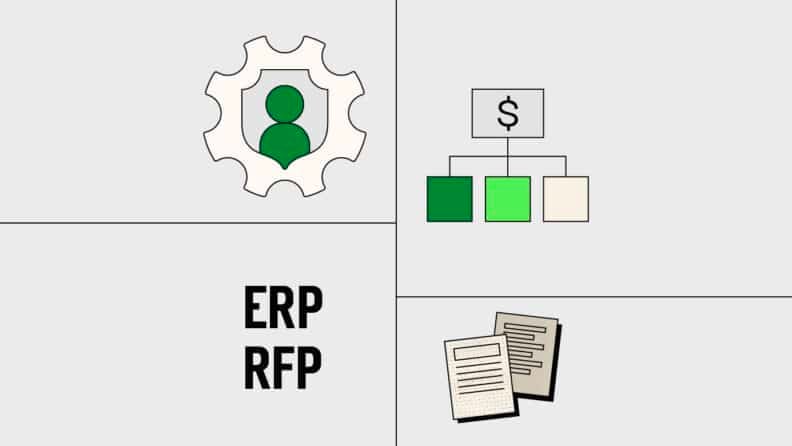An ERP RFP is like a dating profile. It should perfectly encapsulate everything about you and what you’re looking for in a partner, a.k.a. ERP vendor.
Well, when you consider the undertaking an ERP system can be, it may be more like marriage than dating. To set you up for a long & happy life together, I’ve created this ERP RFP guide with a recommended structure, RFP best practices, and real-world examples.
Shall we?
What is an ERP RFP?
An RFP is a detailed document that outlines your project scope, ERP requirements, and proposal review process for potential vendors. Like a well-crafted dating profile, an effective RFP attracts the right matches and sets the foundation for a successful long-term relationship.
From the vendor’s perspective, it’s an opportunity to earn your business. However, just like any potential suitor, they'll need some guidance to craft a proposal that truly captures your heart. Help them win your favor by providing essential information in your RFP like:
- Must-have features and functionalities
- Preferred deployment method (cloud, on-premise, or hybrid)
- Existing system specifications
- Analytics and reporting capabilities
Include as much as you can—the more vendors know about your ERP software requirements, the better the proposals you receive will be.
Benefits of an ERP RFP
Creating an RFP is a time-consuming process, with some businesses dedicating whole teams to this endeavor. However, its benefits justify the effort.
- It saves you time. With an RFP, the vendor has to prove their ERP is the right fit, saving you time that would have gone into researching and understanding the system.
- It forces you to think. Listing out your requirements helps you organize, articulate, and document your ERP vision and expectations.
- It helps you find the right ERP vendor. A vendor’s RFP response is a great way to judge their work ethic, processes, and interest in the project.
RFP vs RFI vs RFQ: What’s the Difference?
The main difference between RFIs, RFPs, and RFQs is that they’re sent out at different points in the information-gathering stage.
The RFI, or Request For Information, is first on the list. It’s used to gather some initial information on the ERP vendor’s offerings.
Once we’ve shortlisted potential candidates from RFI responses, RFPs will be distributed with detailed information to prepare a personalized proposal.
Finally, you have the RFQ or Request For Quote. It is sent to the most compatible vendors, asking for a detailed quote with technical specifications, deployment plans, payment terms, maintenance offerings, and service level agreements (SLAs).
Do You Need an ERP RFP?
Preparing RFPs and reviewing vendor submissions is time-consuming. So before getting started, ask yourself: is it worth the effort?
To help you answer this existential question, let’s look at when you don’t need an RFP:
- You’re a smaller business, around $5 million to $30 million in revenue.
- You have simple business processes.
- You trust the vendor to successfully implement the ERP.
If you fall into this camp, standard ERP systems are going to do the trick — and these are the best options currently on the market:
On the other hand, consider an RFP if:
- You don’t know how to approach the ERP selection process.
- You aren’t clear on the value of the ERP.
- You run a large business with complex processes.
- You want all stakeholders to have a clear understanding of the ERP scope.
It's cool, I get weirdly excited about financial technology too — you've already voted in this poll, though.
ERP RFP Requirements
RFP documents don’t have a standard format. Their main purpose is to ensure vendors have all the information to create a stunning proposal. Here are a few standard points every RFP should cover:
1. Your Business History
Including a brief background about your business — like company profile, vision, and services — helps potential vendors assess if they’re the right fit. It also helps them understand your business needs and can bring valuable insights and best practices to the table.
2. ERP Functional and Training Requirements
It lists all your new ERP system requirements, including core features, modules, integrations, required upgrades, and use cases. Be as detailed as you want in this section because vendors will use this to prepare a personalized proposal to fulfill your requirements.
3. Vendor Information Request
You can use this section to ask for specific details about the vendor to assess. It usually covers information like:
- Vendor’s organizational structure to understand their reporting hierarchy, organizational size, and point of contact. The more complex their organizational structure, the longer it’ll take to complete the project.
- Vendor’s profile, including the company history, ERP projects, clients, and references. This will help you assess the company’s experience and project management skills.
- Vendor’s implementation methodology to understand their processes and how long the project will take.
- Third-party partners that the vendor may use during implementation or to support specific ERP functions.
- Post-implementation service to scope out the different customer support options provided by the vendor after ERP implementation. Like help desks, security, data backup, troubleshooting, and training.
4. Additional Information
Along with the aforementioned must-haves, here are a few additional areas you can collect information on:
Industry-specific requirements
List any custom ERP requirements here. Cover everything your ERP needs to function optimally in your industry.
For example, if you work in the manufacturing sector, your ERP needs to connect with your inventory management, procurement management, and supply chain systems.
Financials
Ask for the vendor’s financial history, like average sales, income breakdown, etc. This will give you an idea about the vendor’s specialization.
For example, if the vendor makes most of their money from maintenance services, you can assume they aren’t very good at implementing ERPs.
Who’s Involved in the ERP RFP Process?
Involving your team members while preparing your RFP is important. They can weigh in on technical and non-technical requirements, help with buy-in, and highlight any obstacles. Here are a few team members you should speak to:
1. Management
The management team could be comprised of just the CEO, or a multi-person C-Suite. Each member should be consulted, as they can offer insights from their point of expertise. For example, the CEO can guide you on the expected ERP impact and culture shift. Meanwhile, the CFO can offer guidance on the financial aspects.
2. Employees
These are the people who will be using the system daily. Their input is crucial for ensuring that the ERP meets their needs and is user-friendly. Moreover, involving them from the start helps identify potential product champions who can offer feedback and help with onboarding other employees.
3. IT
They know your current setup inside out. Tapping into their knowledge can help you understand technical requirements while prepping the RFP. They can also establish security requirements vendors need to address in the proposal.
How To Write an ERP RFP
RFPs pack in a lot of information. To make it easier to understand, divide the information into the following sections:
1. Introduction
A good intro is short, concise, and effectively summarizes the organization’s objectives and challenges.
Below is an example of a well-written introduction from Leech Lake News. It summarizes the document’s intentions and contents, followed by a brief background about the organization.

Go CRAZY with it, if you're into that
You can include the company background separately, depending on how much information you want to share.
2. Company History
This section usually includes a brief organizational history, company mission, values, and market share — anything that’ll help vendors understand your business better. You can also include key projects, milestones, and achievements.
Here’s a good example from Dawson’s College. It highlights the college’s history, educational programs, accreditations, and current setup.
3. System Requirements
This section will detail all your ERP specifications, requirements, and needs you’re looking to solve.
To make it easier to understand, break it down into different categories like Technical Specifications, Functional Requirements, Security Protocols, and User Experience.
Dawson College does this well in its ERP RFP, starting with expected ERP capabilities:
It’s followed by what a successful RFP implementation should look like from the college’s point of view:
You can also include information about your current ERP setup (if you have one) so vendors can account for any data migration or integrations, like the City of Gilroy did in their RFP:
4. Proposal Format
List out any required sections, headings, supporting documents, and materials vendors have to include with their proposals. The City of Gilroy has done this well in their RFP:
I also came across the City of Saint John’s ERP RFP that provided vendor submission forms to add their information.
5. Timeline
Provide clear deadlines for proposal submission, review, project start date, and date of announcing the winning ERP vendor. You can have as many checkpoints as you like; as long as vendors have ample time to prepare and submit their proposals.
The Best Way to Structure Your RFP
There isn’t a fixed ERP RFP template. However, I did find some similarities. I’ve used that to come up with a structure covering the salient points:
- Introduction
- Company profile
- Contact details
- Project summary
- Proposal requirements summary
- ERP Requirements
- Scope of the ERP
- Current ERP setup and challenges
- Expected ERP functionalities and goals
- Vendor Information
- Contact information
- Previous projects and outcomes
- Awards and accolades
- References
- Pricing breakdown
- Evaluation Process
- Structured proposal format
- Evaluation criteria and scores
- Timelines
RFP Issuance Timeline
Creating and issuing an RFP can take between 1-15 working days. However, it can vary depending on team size and complexity of your requirements.

Getting Your RFP In Front Of The Right People
Sales, marketing, or business development teams are usually the right people for an RFP.
Keep the communication short and to the point, covering salient points about your company, business, and expected date of response.
Set yourself up for success
You can club this in with your RFI to speed up the process.
After the response date passes, send the RFP to the vendors who responded positively, as it indicates their interest in working on the project.
Evaluating ERP RFP Responses
Taking a methodical approach to assessing RFP responses will ensure that you move through vendor proposals quickly. It’ll also give the vendor clarity about the selection process.
Step 1: Rank Vendors
Assess whether each vendor’s proposal addresses all your ERP requirements. If it does, that means the vendor has understood the assignment.
Step 2: Assess Post-Implementation Support
Even after implementation, you may need some help. Compare the maintenance and support options offered by the vendors and select the ones that offer the most comprehensive support.
Step 3: Arrange Demos
If they’ve passed the first two tests, it’s time to check out how the product works. Schedule a product demo with the vendor to see the solution in action and ask any questions.
I’d recommend going with the vendor that tailors their demos to your business. It shows proactivity and an understanding of your requirements.
Step 4: Ask About Pricing
Finally, ask your finalists for a detailed pricing plan. Get on a call and iron out any final details about the contract. Having a mutual understanding from the get-go will help avoid any misunderstandings in the future.
Subscribe For More ERP Implementation Insights
Have some unanswered questions about ERP implementation? Subscribe to our free newsletter for expert advice, guides, and insights from experts in the ERP industry.




